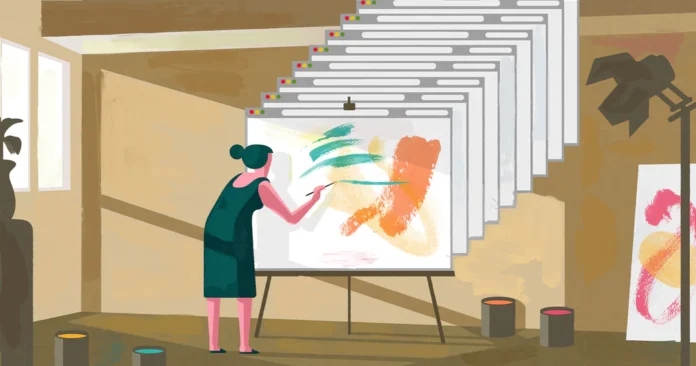Are you an artist dreaming of turning your passion into profit? Do you have a unique digital art style that you’d love to monetize? Now is the time! Here, we provide you with practical tips and strategies that will help you take your artwork to the next level. You can make a living doing what you love and we’ll show you how!
Developing a Professional Brand

Creating a professional brand is essential for monetizing your digital art. Your brand conveys an image of yourself as a serious and responsible artist, which helps you attract potential customers and build relationships with them. To create a strong brand, consider the following steps:
-
Identify Your Goals
Think about what you want to achieve with your craft. Are you looking to attract more clients or launch your own business? What type of income do you want to generate? Answering these questions will help you form a strategy and create meaningful goals.
-
Utilize Platforms Specific to Artists
Platforms like Linkr Store allow artists to get paid for their work on an ongoing basis by fans who are willing to support their work financially via subscriptions or one-time payments. You can use these platforms to sell material such as tutorials, schematics, or physical products like prints or books related to your artwork—and make some extra money while doing so!
-
Build an Online Presence
Establishing an online presence will help make it easier for people to find and connect with you. Use social media accounts, such as Twitter, Instagram, or Facebook, to promote your art and engage with potential customers. You can also create a blog where people can access information about your artwork and progress.
-
Invest in Professional Quality Images & Videos
Investing in high-quality images and videos is crucial when it comes time to showcase your artwork online. Professional photos and videos give potential customers more confidence in the quality of the product they’re investing in, which could translate into increased sales for you!
Creating a Digital Art Portfolio

Creating a digital portfolio is a great way to show potential customers the range of your artistic talents. Not only is it an effective marketing tool, but it also allows you to pre-set prices.
Start by curating a selection of your best works; this will be displayed on your portfolio site and will give viewers an idea of the quality of your work and the types of pieces you create. Be sure to list all available sizes, details, and pricing for each work — this will make it much easier for fans to purchase from you directly rather than having to contact you with questions.
If possible, consider featuring video or audio interviews with clients who have commissioned works from you in the past so potential customers can get an idea of how their own projects might turn out. Additionally, if you offer customizations for clients, allow them to share their personalized pieces on the website as well. This allows others to see what can be done with a relatively low budget or time investment.
Pricing Your Artwork

Artists should think carefully about how to price their digital artwork, as this will be a major factor for potential customers. It’s important to consider the time you spend on your piece and the elements that you incorporate, and then compare it to similar pieces from fellow artists.
The goal is to generate fair compensation for your creative efforts without pricing yourself out of the market or undervaluing yourself. A good starting point is determining a price range and then continuing to adjust based on market demand and customer feedback. In addition, consider time-based discounts or special offers for members of specific groups or organizations.
Depending on the type of artwork being sold and your licensing agreement with the customer, use elements such as royalties, flat fees, subscription fees, or commission-based pricing when establishing prices for digital artwork. Additionally, some online platforms offer their own customer payment programs that handle transaction costs while allowing customers more ways to purchase art. Consider researching these options so you can choose an appropriate plan that fits your business needs while also maximizing profitability.
Selling Your Art Online

Selling your art online can be a great way to make money from your creative process and reach potential buyers around the world. To start, you’ll need a website for your digital art portfolio, but there are also free resources like Etsy and ArtFire that you can use to market and list your work. You can also check out social media outlets like Instagram, Facebook, and Twitter to spread the word about your artwork and draw in new customers.
Once you establish an online presence, there are several techniques that you can use to monetize your art. For example, you can charge per customization or offer discounts in exchange for bulk orders. Additionally, if customers are interested in selling their own work using yours as inspiration, consider using a royalties system where they pay a fee for the right to produce commissions of that particular piece. You could also start selling limited edition prints of specialized pieces at various websites if you’re looking for greater exposure.
However one of the most important things you need to keep in mind is pricing – set prices at a point that reflects the value both for yourself as well as for what potential clients may be willing to pay for such artwork. As long as these costs remain reasonable and competitive with other such sellers who offer broadly similar products or services, people will be more inclined to buy from them. As always, it helps if good customer service too.
Conclusion
Monetizing your passion can be a challenging and rewarding experience. With the right approach, you can create a profitable business from your digital art. By taking advantage of social media and online platforms, creating merchandise, and marketing yourself to potential customers, you can turn your creative work into profit for yourself. With dedication and hard work, it is possible to make money doing something that makes you happy.









